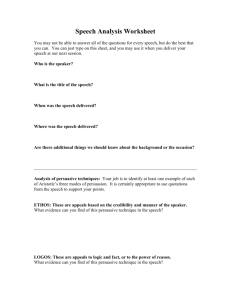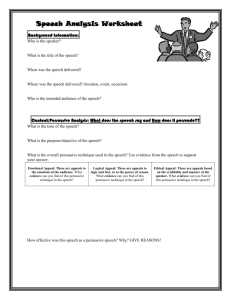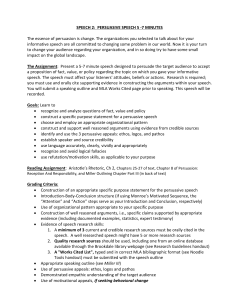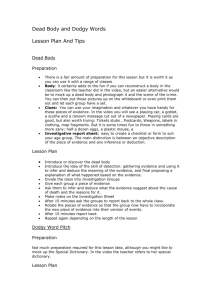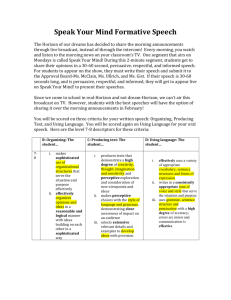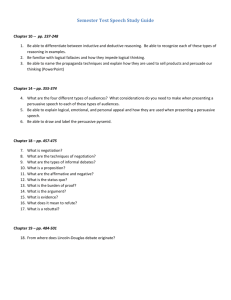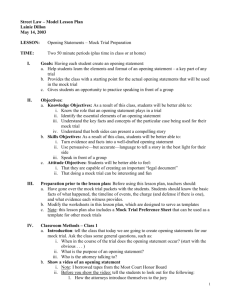It`s no secret that public speaking can be a a nerve racking
advertisement
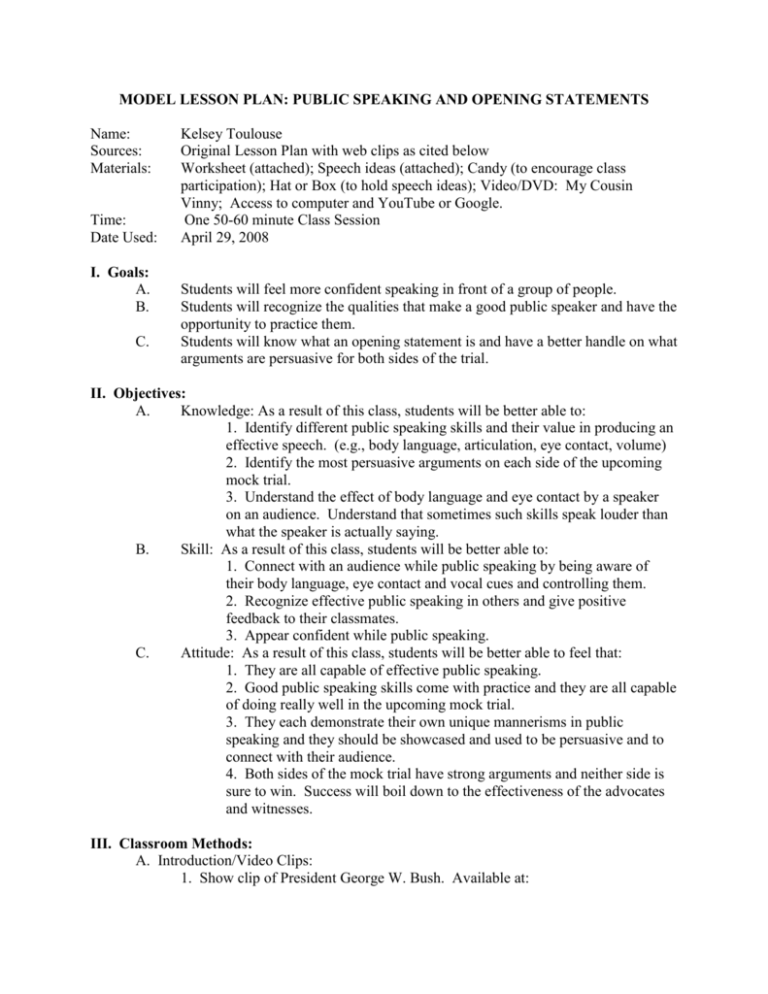
MODEL LESSON PLAN: PUBLIC SPEAKING AND OPENING STATEMENTS Name: Sources: Materials: Time: Date Used: I. Goals: A. B. C. Kelsey Toulouse Original Lesson Plan with web clips as cited below Worksheet (attached); Speech ideas (attached); Candy (to encourage class participation); Hat or Box (to hold speech ideas); Video/DVD: My Cousin Vinny; Access to computer and YouTube or Google. One 50-60 minute Class Session April 29, 2008 Students will feel more confident speaking in front of a group of people. Students will recognize the qualities that make a good public speaker and have the opportunity to practice them. Students will know what an opening statement is and have a better handle on what arguments are persuasive for both sides of the trial. II. Objectives: A. Knowledge: As a result of this class, students will be better able to: 1. Identify different public speaking skills and their value in producing an effective speech. (e.g., body language, articulation, eye contact, volume) 2. Identify the most persuasive arguments on each side of the upcoming mock trial. 3. Understand the effect of body language and eye contact by a speaker on an audience. Understand that sometimes such skills speak louder than what the speaker is actually saying. B. Skill: As a result of this class, students will be better able to: 1. Connect with an audience while public speaking by being aware of their body language, eye contact and vocal cues and controlling them. 2. Recognize effective public speaking in others and give positive feedback to their classmates. 3. Appear confident while public speaking. C. Attitude: As a result of this class, students will be better able to feel that: 1. They are all capable of effective public speaking. 2. Good public speaking skills come with practice and they are all capable of doing really well in the upcoming mock trial. 3. They each demonstrate their own unique mannerisms in public speaking and they should be showcased and used to be persuasive and to connect with their audience. 4. Both sides of the mock trial have strong arguments and neither side is sure to win. Success will boil down to the effectiveness of the advocates and witnesses. III. Classroom Methods: A. Introduction/Video Clips: 1. Show clip of President George W. Bush. Available at: i.http://video.google.com/videoplay?docid=3534791936101725686&q=& hl=en (google) OR ii. http://www.youtube.com/watch?v=BqLvBUSJucg (youtube) 2. Questions: i. Is President Bush an intelligent man? ii. Why do you think so? iii. When he speaks what do you think he does well? iv. What do you think he could do better? v. How many of you get nervous when you speak? vi. Do you think that President Bush gets nervous? 3. Show clip from movie: “My Cousin Vinny:” i. Access: Scene 16 on DVD; Rewind slightly to show Joe Pesci in his maroon tux explaining to the court why he is wearing that particular outfit. ii. Prior to showing the scene explain to the class that there are three attorneys: Prosecutor and two defense attorneys. iii. Review the roles of prosecutor and defense attorneys if there are any questions. 4. After the Clip: Questions i. Prosecuting Attorney: a. What did he do well? b. What would you change if you were speaking to the jury? ii. Defense Attorney(s): a. Were they effective public speakers? Why/Why not? iii. Name some people you think are good public speakers. iv. What makes them good? v. What skills do you think are required to be a good speaker? B. Mini-Lecture on Public Speaking: 1. In most studies, the fear of public speaking is the #1 fear of the American people. Death is #2. As Jerry Seinfeld would say, that means that at a funeral, most people would rather be in the coffin than delivering the eulogy. 2. How many of you fear public speaking? What do you do when you are nervous and you have to speak? 3. Despite your fears, all of you are going to have a speaking role in our mock trial and it is important that we recognize what characteristics make effective public speakers. Today, we are going to review the skills required and each of you is going to have the chance to practice using them. 4. Let’s talk about what skills are required. And it does require skills. Some of you may think that public speaking is a gift that some people have and most don’t. It isn’t. Anyone can become a good public speaker and we’re going to talk about how. 5. Put up the worksheet. (See attached.) Talk about each one. i. Be Organized: a. It is so important that students put in the effort to know the case (for mock trial) or whatever their topic is before they present it. b. It is okay to use index cards to keep your thoughts straight, though when possible only use bullet points to highlight topics you can’t forget. Don’t write your whole speech down. ii. Be Clear: a. You don’t have to use big words. Think of it as a conversation between you and your audience. If they don’t know what your words mean, they won’t be able to follow you. b. Silence is not your enemy. Avoid fillers like, “uh” and “um,” instead take a moment to collect your thoughts and begin again. c. Slow down. Make sure that your audience not only understands what you are saying, but that they can follow you. iii. Be Direct: (Eyes) a. Eye contact is one of the best ways to connect to your audience. Make sure you look at them. You don’t need to focus on them the entire time, but to follow the example used before, if you are just having a conversation with your audience, how much would you look at them? b. Picture them naked? This is a common saying to help speakers relax. Instead just remember that they are as nervous public speaking as you are. They know you are nervous, but they also know that you have information that they don’t have. You are the only person who can give them that information. Look them in the eye while doing it. Look at the whole group, not just one person. iv. Be Open: (Body Language) a. Posture and body language are very important. If I talk to you with my arms crossed. What do you think? (ask student opinion of you as a speaker with arms crossed). What if I use my hands while I speak? Does that change your impression? b. Standing up straight and keeping your body open to your audience is really important. Don’t lean against a podium or slouch your shoulders. Standing up straight portrays confidence even if you don’t feel that way. v. Be Vocal! (Voice) a. Speak up! I’ve heard most of you around school and I know that you know how to make your voices carry. When you get up in front of a group, make sure they can hear you. b. If a speaker has to strain to hear you (b/c you are too soft) or figure out what you are saying (b/c you are mumbling) they aren’t focused on what you are saying. c. Delivery is so important! vi. Be Yourself! a. There is no one perfect way to deliver an effective public speech. All of you have your own ways of saying things and presenting yourself that are unique and great. Your audience is sure to relate best to what you are saying when you are being yourself. C. Public Speaking Activity: (“1 minute speeches”) 1. Write down various topics that will be relatively easy for high school kids to talk about for at least a minute. (there is a list attached) Topics should be simple so that students can focus on eye contact, body language and gaining confidence, rather that on the argument they are making. 2. Cut each topic out and fold it up. 3. Use a hat or other container and place all the topics inside. 4. Explain to the students that they will each be speaking on a random topic for a minute in front of the class. The topics are folded so students are unaware what they are drawing before they do it. 5. First, ask for volunteers. If no students volunteer begin walking around the room and randomly choose students. Place the hat or container by them and ask them to draw. 6. Students should walk to the front of the room and announce their topic before beginning their speech. 7. When the speech is over, ask the student what he/she did well and what he she would like to improve upon. 8. Open it up to the rest of the class for positive feedback. (While kids are making speeches, put words, body language, voice, and eyes on the overhead.) After each speech ask students to provide some positive feedback on those areas, as well as other things they may have noticed. 9. Repeat this same process until every student in the class has had an opportunity to speak. D. Short Discussion on Opening Statements: 1. Ask Students Questions (provide candy for those who participate): i. What is an opening statement? (An opening statement can be made by both sides in a criminal or civil case and it basically lays out the side’s theory of the case.) ii. Who goes first? Why? (The prosecution/plaintiff goes first b/c it is the side that has charge the defendant with the crime or wrong and must prove its case. The burden of proof is on the prosecution.) iii. In review, what is the burden of proof in a criminal case? (Beyond a reasonable doubt.) iv. Who are the prosecution and defense talking to during their opening statements? (The jury, because the jury decides whether a defendant is guilty or innocent.) v. What do you think makes an opening statement effective? (Students will hopefully list off the public speaking characteristics discussed earlier. They might also point out that how an attorney looks or sounds can be very important. vi.. They say that first impressions are really important. Do you think that what a jury thinks of an attorney during opening statements sticks with them? (Yes.) vii. What is the difference between the kind of speeches we did earlier and opening statements? (Opening statements are persuasive speaking. Not only must an attorney have good eye contact and body language, they must also argue rather than just stating facts. Opening statements is when a jury gets to hear the prosecution and defense arguments for the first time and also gets its first impression of how strong the case is. iix. It is really important that attorneys making opening statements plan their opening statements carefully and make sure that all the most persuasive facts for their case are in there. E. Group Brainstorming Session: i. Based on the mock trial packet (which students already have and have read), ask students to state the most persuasive arguments for each side and who (which witness) is providing the evidence. ii. Start with the prosecution; Ask students to raise their hands and state the strongest, most persuasive evidence for the prosecution. 1. Why is that evidence important? 2. What does it add to the argument? iii. Next, make another column on the overhead for the defense; Ask for persuasive arguments for the defense iv. Ask one student to copy the list on a sheet of paper for the prosecution and one student for the defendant. v. Include the lists of arguments in the trial notebook for the students who will eventually write an opening statement. IV. Assessment: A. Class Participation B. Homework: Assign half of the class to write a persuasive paragraph supporting the defense argument for the upcoming mock trial. Assign the other half to the prosecution argument. Students can use the arguments discussed in class. Paragraphs should be due at the next Street Law session. THE 6 “BEs” OF EFFECTIVE PUBLIC SPEAKING: 1. Be Organized! a. Being prepared breeds confidence. b. Write down key ideas on a notecard to keep your thoughts straight. c. Research. Don’t just fake it! 2. Be Clear! (Words) a. Simple is best! b. If you don’t understand it, neither will your audience. c. Avoid fillers: uh, um, like, mmm… d. Avoid repetitive phrases: “let’s see…,” “let me think,” “another thing” e. Silence is not your enemy! Pausing to collect your thoughts or take a deep breath is okay. 3. Be Direct! (Eyes) a. Picture your audience naked?? b. Make eye contact. c. Don’t be afraid to look down to collect your thoughts but be confident. You know the material d. Make your audience believe! 4. Be Open! (Body Language) a. Posture. Standing up straight makes you look like you are in control. b. Open arms. c. Using your hands can be very effective! d. Chin up! 5. Be Vocal! (Voice) a. volume, VOLUME, VOLUME b. Enunciate c. Speak TO your audience! d. No mumbling! e. Slow down! 6. Be Yourself! a. Your audience will forgive your nervousness, but they will be turned off by fake modesty or bravado. FAKE IT UNTIL YOU MAKE IT! More Speech Tips: a. Don’t point out your own mistakes or apologize. You are the expert on this topic during the time your speech is made! b. Look the part! If the occasion calls for a tuxedo, don’t show up in shorts and sandals. No matter how well you speak, the audience may have trouble focusing on anything but your clothes. c. Know your arguments! Confidence comes from feeling prepared. Avoid reading every word to your audience from a speech or index card. d. If you stumble don’t repeat sentences or phrases unless they are pivotal to what you are saying. e. Finish your speech before your audience does. Leave them wanting more. f. BE CONFIDENT! You can do this! Topics for One-Minute Speeches: Politics Religion College Summer: What are you going to do? What would you like to do? Ice cream High school student jobs Parents Siblings High School Chief Sealth West Seattle Washington State: Why do you like/dislike it? Cheating in school Your pet Favorite television show? Why? Favorite foods Getting good grades Music Gun control Marriage Vacations A foreign country that you’ve been to or where you want to go Favorite memory Video games Family Money Monday Saturday Home Schooling Abortion School prayer School violence Police Favorite teacher What are your career goals? Why? Three things you want w/ you on a deserted island. What would you do if you were given $1 million? If you had three wishes granted what would they be? Choose three words to describe yourself. Tell us why you chose them. What do you do for Christmas?
